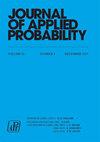费勒过程驱动的SIR流行病
IF 0.7
4区 数学
Q3 STATISTICS & PROBABILITY
引用次数: 0
摘要
我们考虑一个随机SIR(易感的$\right - row$感染的$\right - row$移除)模型,在该模型中,感染周期由一组独立且相同分布的Feller过程调制。每一个受感染的个体都与这些过程中的一个有关,这些过程的轨迹决定了他的感染期的持续时间、他的污染率和他的清除方式(例如死亡或免疫)。我们使用鞅方法推导了该模型的最终流行病规模和严重程度的分布,并提供了一些一般示例。接下来,我们将重点放在面对给定数量易感物的单个感染者身上,并确定其结果的分布(污染数量、严重程度、清除类型)。使用模型的离散时间公式,我们表明这种分布也为我们提供了一种替代的,更稳定的方法来计算最终的流行病结果分布。本文章由计算机程序翻译,如有差异,请以英文原文为准。
SIR epidemics driven by Feller processes
We consider a stochastic SIR (susceptible
$\rightarrow$
infective
$\rightarrow$
removed) model in which the infectious periods are modulated by a collection of independent and identically distributed Feller processes. Each infected individual is associated with one of these processes, the trajectories of which determine the duration of his infectious period, his contamination rate, and his type of removal (e.g. death or immunization). We use a martingale approach to derive the distribution of the final epidemic size and severity for this model and provide some general examples. Next, we focus on a single infected individual facing a given number of susceptibles, and we determine the distribution of his outcome (number of contaminations, severity, type of removal). Using a discrete-time formulation of the model, we show that this distribution also provides us with an alternative, more stable method to compute the final epidemic outcome distribution.
求助全文
通过发布文献求助,成功后即可免费获取论文全文。
去求助
来源期刊

Journal of Applied Probability
数学-统计学与概率论
CiteScore
1.50
自引率
10.00%
发文量
92
审稿时长
6-12 weeks
期刊介绍:
Journal of Applied Probability is the oldest journal devoted to the publication of research in the field of applied probability. It is an international journal published by the Applied Probability Trust, and it serves as a companion publication to the Advances in Applied Probability. Its wide audience includes leading researchers across the entire spectrum of applied probability, including biosciences applications, operations research, telecommunications, computer science, engineering, epidemiology, financial mathematics, the physical and social sciences, and any field where stochastic modeling is used.
A submission to Applied Probability represents a submission that may, at the Editor-in-Chief’s discretion, appear in either the Journal of Applied Probability or the Advances in Applied Probability. Typically, shorter papers appear in the Journal, with longer contributions appearing in the Advances.
 求助内容:
求助内容: 应助结果提醒方式:
应助结果提醒方式:


